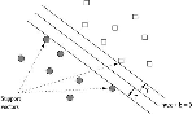Database Reference
In-Depth Information
(c) Suggest a transformation using quadratic polynomials that will transform these
points so they become linearly separable.
12.3 Support-Vector Machines
We can view a
support-vector machine
, or SVM, as an improvement on the perceptron that
is designed to address the problems mentioned in
Section 12.2.7
.
An SVM selects one par-
ticular hyperplane that not only separates the points in the two classes, but does so in a way
that maximizes the
margin
- the distance between the hyperplane and the closest points of
the training set.
12.3.1
The Mechanics of an SVM
γ
between the hyperplane and any point of the training set. The idea is suggested by
Fig.
Figure 12.14
An SVM selects the hyperplane with the greatest possible margin
γ
between the hyperplane and the train-
ing points
Intuitively, we are more certain of the class of points that are far from the separating
hyperplane than we are of points near to that hyperplane. Thus, it is desirable that all the
training points be as far from the hyperplane as possible (but on the correct side of that
hyperplane, of course). An added advantage of choosing the separating hyperplane to have
as large a margin as possible is that there may be points closer to the hyperplane in the
full data set but not in the training set. If so, we have a better chance that these points will
be classified properly than if we chose a hyperplane that separated the training points but
allowed some points to be very close to the hyperplane itself. In that case, there is a fair
chance that a new point that was near a training point that was also near the hyperplane
would be misclassified. This issue was discussed in
Section 12.2.7
in connection with
Fig.

